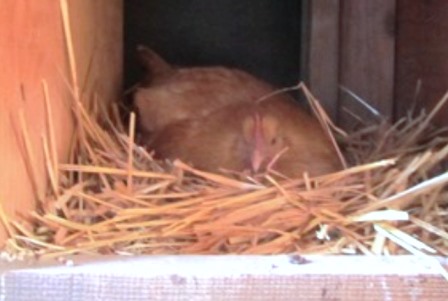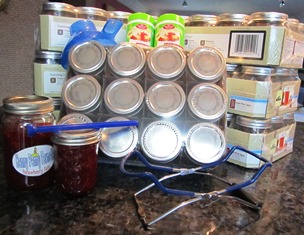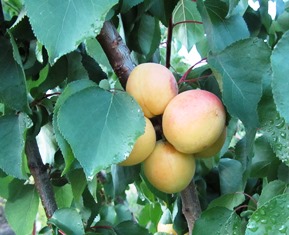A Broody Hen, A Clutch of Eggs, and No Rooster
My little yellow Buff Orpington {as yet unnamed) has gone broody. I didn’t know this behavior could happen so early in her young life. At 20 weeks, she’s only just started laying eggs. Now all she wants to do is sit on them.
Like an expectant mother, she contentedly sits, apparently anticipating the arrival of her chicklets (in 21 days). I don’t have the heart to tell her that she needed a rendezvous with a rooster to get eggs that will hatch. And, in case she hasn’t noticed, we don’t have a rooster.
She’s become a fixture on the nesting box, forcing the other chickens to lay their eggs in the other two. Buff O. sits on the eggs (who knows how many are under her) with a glazed look in her eyes. If I go near her nesting box, she puffs up and ruffles her feathers like an attack chicken.
She must leave the nest to eat, drink, and poop . . . . but I haven’t witnessed it, so I have put containers of food and water near the nest. I don’t want her losing weight or getting sick during her sit-in.
At first, sensing that she was behaving strangely and fearful that something be wrong with her, I began searching the Internet. Apparently some breeds like Silkies, and Cochins have a tendency to go broody. And, they can go broody more than once during the year. See, http://blog.mypetchicken.com/2012/02/01/what-is-a-broody-hen.
Apparently, dictated by their biology, laying hens decide to sit on a clutch of eggs, even rolling other chickens’ eggs under them if there aren’t enough. The laying hen will rotate her body to redirect heat evenly over the eggs or pluck out her own chest feathers to create more warmth and moisture for the eggs. In the case of my hen, I’m trying to imagine a bare-chested chicken sitting on a clutch of eggs that will never hatch.
Broody hens will even talk to the eggs (and the little chicks growing inside). It’s mommy business they are attending to. However, once a hen has gone broody, she will stop laying. And as for the mommy business, I have no idea how my Buff Orpington will figure out that those eggs she’s so carefully guarding . . . well, they’re just eggs.
Sun Drying Apricots
My husband supports my obsession for making jam and otherwise preserving summer’s bounty. Two weeks ago he brought home five cases of organic apricots and cherries from the farmers market and cases of canning jars. Yesterday he brought me seven more cases of canning jars with rings and lids.
The fruit on the apricot trees here on the farmette is ripening now. So are the yellow and small red plums. The figs and apples will come later but the trees are already heavily laden. I have canned dozens of jars of jam. I think I will dry some apricots.
Sun drying apricots requires 2 to 4 days of hot sun (preferably above 98 degrees) for the fruit to lose its moisture and turn leathery. Luckily, our local weather forecast is temperatures at the end of next week to hover in the mid- to upper 90 degrees Fahrenheit. High temps and low humidity are key to successful sun drying of fruit.
Here’s the process I use.
Step 1. Gather together the equipment such as a drying table; trays to hold the fruit; and cheese cloth or a screen to protect from insects, flying leaves, dust, birds, and the like.
Step 2. Wash the fruit, cut into two pieces, and remove the pits.
Step 3. Dip fruit into crystalline ascorbic acid–1 teaspoon to 1 cup of water to prevent fruit browning. Or, dip fruit for 3-5 minutes in lemon, lime, or orange juice. But after two batches are dipped, replace with fresh juice. Drain well after dipping.
Caveat: Sulfuring of apricots and other dried fruits produces an excellent product, but is to be avoided if you suffer from asthma because it can trigger an asthma attack. I stay away from sulfured products precisely because of this reason.
Step 3. Place fruit in a single layer. Similar size pieces of apricot will dry in approximately the same length of time.
Step 4. Cover trays with cheesecloth or a screen. Test for perfectly dried fruit–no moisture present when an edge is cut. The fruit will be pliable.
 Facebook
Facebook Goodreads
Goodreads LinkedIn
LinkedIn Meera Lester
Meera Lester Twitter
Twitter








